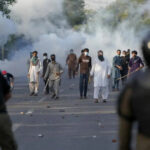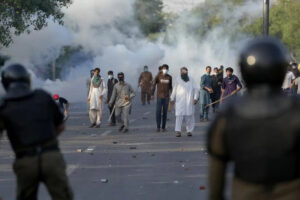Pakistan is officially out of the ongoing Asia Cup.
The Men in Green have one of the best top-order batters in the world, namely skipper Babar Azam, as well as Imam-ul-Haq and Fakhar Zaman, and a brilliant pace attack of Shaheen Shah Afridi, Naseem Shah and Haris Rauf.
Charith Asalanka sealed Sri Lanka’s date with India in the Asia Cup 2023 final after clinching a two-wicket victory in a nerve-cracking chase against Pakistan on Thursday at the R Premadasa Stadium.
Pakistan’s pace attack was one of the most hyped things about the tournament. The pace trio of Shaheen-Naseem-Haris made an immediate impact, bundling out Nepal for a low score demolishing India’s top order and performing well in death overs.
In the group stage, out of 20 wickets, Shaheen-Naseem-Rauf took 15 wickets combined, with Shaheen getting six and Rauf getting five and Naseem four.
Pakistan went into the Super Four stage with their pace battery playing a vital role in their progress. In the first clash against Bangladesh, Pakistan once again delivered an all-round show as not only their batters led the side to a seven-wicket win, but Shaheen-Naseem-Rauf combined for eight wickets, with Rauf taking four. Pace-bowling all-rounder Faheem Ashraf also got a wicket.
Till this point, Pakistan’s pace battery had delivered 68.3 overs, taking 24 wickets at an average of 12.95. Their strike rate was 17.1 and the economy rate was 4.54. Rauf was the leading wicket-taker in the tournament with nine, Shaheen taking seven wickets and Naseem getting seven. Ashraf got one wicket.
But everything changed during their match against India in the Super Four stage. After the top order was sent back to the pavilion cheaply in the group stage, Men in Blue came back with a vengeance. Openers Rohit Sharma and Shubman Gill set the tone for the innings with a century partnership. Particularly Gill, who was struggling against express pace in the first match against Pakistan, now had come well-prepared with a game plan to take them down and felt at ease with their pace. KL Rahul and Virat Kohli also slammed centuries to take India to 356/2.
But in the process, Pakistan lost two of its pacers, Rauf and Naseem, to injuries. They were taken to the cleaners in the match. Shaheen got one wicket, but gave away 79 runs in 10 overs. Naseem conceded 53 runs in 9.2 overs and went wicketless. Rauf could bowl only five wicketless overs before injury, in which he gave away 27 runs. Ashraf was also hit for 74 runs in 10 overs.
With their skipper Babar Azam out for cheap and two players injured, the morale of Men in Green took a downward path, and while batting they surrendered to Kuldeep Yadav’s spin. They were all out for 128 and lost the match by 228 runs.
In the next match against Sri Lanka, a must-win encounter, Pakistan drafted Mohammad Wasim Jnr and Zaman Khan into the side in the absence of two of their premier pacers, with Naseem ruled out and Rauf rested. During the defence of 252 runs in a 42-over-per-side affair, the Pakistan pace battery looked like a shadow of what it was during the tournament. Rauf and Naseem’s absence affected the team. Shaheen leaked 52 runs in nine overs and took two wickets, Zaman went wicketless in his six overs and gave away 39 runs and Wasim also gave away 25 runs in just three overs. Zaman failed to defend eight runs in the last over, and thanks to a cool finish by Charith Asalanka, SL won the match by two wickets and cruised to the finals.
After the Bangladesh Super Four clash, the number of pacers faced a downfall. In 52.2 overs they bowled, they could take just three wickets at an average of 116.33. Their strike rate was 104.6 and the economy rate was 6.66. All the three wickets went to Shaheen. Faheem, Zaman, and Wasim failed to make an impact.
Will the world’s top pace attack be able to get back to normal ahead of the ICC Cricket World Cup from October 5 onwards, only time will tell.
Source: ANI News















